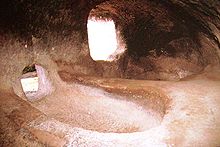- Ozieri culture
-
A statuette of the Mediterranean Mother goddess, found at Senorbì.

The Ozieri culture (or San Michele culture) was a prehistoric pre-Nuragic culture that lived in Sardinia from c. 3200 to 2800 BC.[1] It takes its name from the locality where the main findings connected with it have been found, the grotto of San Michele near Ozieri, in northern Sardinia. The influence of the culture extended also to the nearby Corsica.[2]
History
The archaeological excavation hold there in 1914 and 1949 found fine worked vases with geometrical motifs carved in the clay and colored with red ochre. The oldest one were still rather crude, while the more recent examples are more refined and slender.
Such ceramics were a novelty for prehistoric Sardinia, since so far they were considered typical of the Cyclades and Crete. The development of the Ozieri culture, therefore, probably stemmed from contacts with other eastern Mediterranean civilizations, in particular from the Neolithic Greece area.[3]
Domus de janas of Villaperuccio.
Villages of the Ozieri culture which have been identified amount to some 200, located both in plain and mountain areas. They were formed by small stone huts, with a circular (rarely rectangular) wall supporting a wooden frame with a ceiling of boughs. One, near Mogoro, included 267 huts, perhaps also erected on poles driven into the ground. The pavements were composed of limestone slabs, of basalt cobbles or clay.
Bull horns sculpted in funerary niche inside a Domus de Janas.
The villages had no walls, and findings of weapons in the tombs are scarce: the Ozieri civilization was thus perhaps a peaceful one, far different from the later Nuragic civilization. The tombs were grouped in the hypogeous structures that later became known as domus de janas, or, as more frequent in Gallura (regarding what is sometimes defined as Arzachena culture), in Megalithic circles. Some tombs, of more monumental appearance, belonged perhaps to chiefs, in the same fashion of those in Crete.
Religion included the adoration of the Neolithic Mother goddess and of a Bull god, perhaps connected to fertility. Female statuettes similar to those of the Ozieri culture have been found in Malta.[4]
References
- ^ Dating from the Sardegna Cultura website
- ^ Antona, Angela. Il complesso nuragico di Su Brandali e i monumenti archeologici di Santa Teresa di Gallura. p. 13.
- ^ Lilliu, Giovanni. "Prima dei nuraghi". La società in Sardegna nei secoli. p. 9.
- ^ Lilliu, G.. "Prima dei nuraghi". La Società in Sardegna nei secoli. p. 16).
Sources
- Giovanni, Lilliu (1967). La civiltà dei Sardi dal neolitico all'età dei nuraghi. Turin: Edizioni ERI.
- __ (1967). La civiltà in Sardegna nei secoli. Turin: Edizioni ERI.
Categories:- Archaeological cultures
- Archaeology of Sardinia
- Neolithic Europe
Wikimedia Foundation. 2010.



